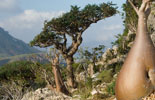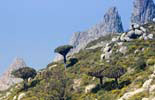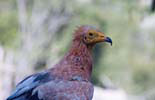 |
 |
 |
|
|||||||||||||
Yemen
DSF's work in Yemen has been especially rewarding. Yemen as a whole presents a sobering profile. Her 21 million people are destined to exceed 71 million by 2050 at current trends. 74% of the nation is rural, male life expectancy a mere 59, females 63, with a daily income average of US$2.27.
It is not surprising, then, that there is widespread trafficking in wildlife and rapid loss of habitat. At least twenty species are known to be Threatened and Endangered, and the Arabian leopard in Yemen all but lost.
But Yemen also harbors an international success story, a treasure, that is spectacular, namely, her "Galapagos of the Indian Ocean," the island archipelago of Socotra where, for Sanctuary: Global Oases of Innocence, we documented rich cultural traditions and remarkable indigenous biodiversity.
Scientists are making new discoveries almost daily on Socotra, a remote mountainous island South of Oman, East of Somalia. In the last 120 years, expeditions to the island have unveiled a veritable ecological renaissance of Socotran zoology. The island is a living font of biodiversification, most notably, among its bottle-trees: Dorstenia gigas gypsophila, Dendrosicyos socotrana, Adenium socotranum and obesum and, the most famous of all, Dracaena cinnabari or Dragon's Blood.
The island's bird life is extensive, with 178 known species recorded here and at least seven endemics. This abundance of taxa coincides with one of the oldest known island sites of continuous human habitation in the world. Today, the population hovers somewhere around 44,000 people. Their linguistic deep lineage pre-dates the Arabic language by millennia, though Arabic is spoken in the Socotran capital of Hadibo.
With kind assistance from the local United Nations -supported Socotra Conservation and Development Programme, we were able to trek into several protected areas and document the Socotran mountain people and their traditional customs of sustaining rare resources and vegetation within numerous ecosystem types.
Once thought of as a kind of Garden of Eden, Socotra retains its unique character. Here are wild Socotran asses, camels, endemic dragonflies, sparrows, breeding Egyptian vultures, but most of all, the woody-based herbal eco-systems supporting wild floral kingdoms biologically unique. The Socotran mountain people have passed down a legacy – so rare in today’s world – of total devotion to sustainability. For thousands of years they have lived in this mindset.Socotra, Yemen




